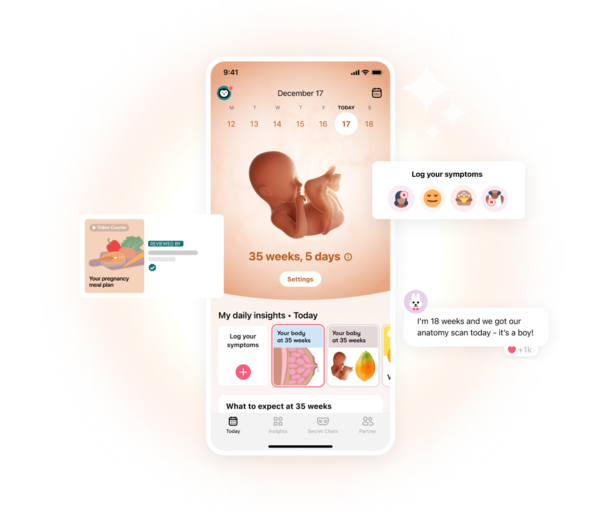You might’ve heard shocking stories about a person who didn’t realize they were pregnant until they were giving birth in a bathroom. When this happens, it’s called a cryptic pregnancy, and it may be more common than you think. Here’s what you need to know about what a cryptic pregnancy is and how to confirm a cryptic pregnancy.
-
Tracking cycle
-
Getting pregnant
-
Pregnancy
-
Help Center
-
Flo for Partners
-
Anonymous Mode
-
Flo app reviews
-
Flo Premium New
-
Secret Chats New
-
Symptom Checker New
-
Your cycle
-
Health 360°
-
Getting pregnant
-
Pregnancy
-
Being a mom
-
LGBTQ+
-
Quizzes
-
Ovulation calculator
-
hCG calculator
-
Pregnancy test calculator
-
Menstrual cycle calculator
-
Period calculator
-
Implantation calculator
-
Pregnancy weeks to months calculator
-
Pregnancy due date calculator
-
IVF and FET due date calculator
-
Due date calculator by ultrasound
-
Medical Affairs
-
Science & Research
-
Pass It On Project New
-
Privacy Portal
-
Press Center
-
Flo Accuracy
-
Careers
-
Contact Us
Cryptic Pregnancy: How Can You Be Pregnant and Not Know?


Every piece of content at Flo Health adheres to the highest editorial standards for language, style, and medical accuracy. To learn what we do to deliver the best health and lifestyle insights to you, check out our content review principles.
What is a cryptic pregnancy?
Can you be pregnant and not know it? The answer is yes, even if you’ve taken pregnancy tests and seen your doctor. Cryptic pregnancy is exactly what it sounds like — a seemingly mysterious pregnancy that goes unnoticed right up until labor begins.
Sometimes called a “stealth pregnancy,” cryptic pregnancies often don’t cause typical pregnancy symptoms. If they do cause symptoms such as fatigue or nausea, they’re mild enough to pass as an upset stomach or a temporary illness.
There are a few reasons why cryptic pregnancies occur. Typically, cryptic pregnancies happen to people who have hormonal imbalances — either due to natural causes, hormonal birth control, or approaching perimenopause.
Take a quiz
Find out what you can do with our Health Assistant
Causes of stealth pregnancy
The primary cause of a stealth pregnancy is hormones. Let’s look at some of the physiological reasons why a person might have a cryptic pregnancy.
If someone was recently pregnant or recently gave birth, it may take time before their hormones return to their regular cycles. During this time — or as long as a person is breastfeeding — they may start ovulating without knowing it, which can result in a cryptic pregnancy. Similarly, perimenopause can lead to irregular hormone cycles and cause a cryptic pregnancy.
Even if someone is on birth control, there’s still a possibility that they can get pregnant if they’re having unprotected sex. If they continue to take birth control while pregnant, they might not experience pregnancy symptoms and therefore have a cryptic pregnancy.
Stress also influences hormones, so high stress can disrupt common pregnancy symptoms. Low body fat can also trigger hormonal imbalances, which might cause a symptomless pregnancy. Polycystic ovary syndrome (PCOS), which causes irregular or elongated hormone cycles, can also cause a cryptic pregnancy.
A secondary, less common cause of cryptic pregnancy is certain psychological conditions. Called a “denial of pregnancy,” it occurs when someone mentally believes they aren’t pregnant, despite tests showing that they are.
How is a negative test result possible?

The primary reason for a stealth pregnancy is hormonal imbalance, but what hormone is going undetected? Getting a negative result on a pregnancy test despite being pregnant is likely caused by low hCG (human chorionic gonadotropin) hormone levels (you can use our online hCG calculator to track your levels if you have the right information to hand).
Other factors can interfere with hCG levels, such as antibiotics, medications, or even fertility drugs.
Another thing that can cause a false negative pregnancy test result is taking the test too soon after a missed period. Many health care providers recommend retaking the test a week after a missed period to double-check the result. Taking the test in the morning may also give a more accurate reading since urine is more concentrated.
Be sure to follow the instructions on the pregnancy test box, and wait for the suggested length of time before checking the results.
Continued periods/bleeding in cryptic pregnancy
Another answer to the question, “can you be pregnant and not know?” is yes if bleeding or spotting during pregnancy is mistaken for menstruation. Bleeding during pregnancy doesn’t always equal miscarriage.
Bleeding or spotting during pregnancy can happen when the embryo attaches to the wall of the uterus, as the endometrial lining sheds, and it can occur throughout the pregnancy as the cervix changes.
How does a cryptic pregnancy go undetected in ultrasound?
Sometimes an ultrasound can miss the fetus in the womb. Typically, health care providers use ultrasound imaging to check for pregnancy in the early stages – between 10 and 13 weeks gestation. It's unlikely to detect a heartbeat by ultrasound before the seventh week of pregnancy. After that, a fetal heartbeat should be easily detectable by transvaginal ultrasound.
Knowing when conception occurred is also important. In early pregnancy, being off by a few days with the estimated last menstrual period or having an irregular ovulation pattern can make a difference in whether or not a heartbeat is detected in an early ultrasound.
If an ultrasound image doesn’t show a pregnancy, it could be because:
- The embryo didn’t implant on the uterus where it usually would.
- The shape or position of the uterus hides the embryo.
Getting an abdominal ultrasound — transvaginal ultrasound is generally much more accurate in early pregnancy.
When an intrauterine pregnancy can’t be identified with reasonable certainty, a blood test to measure hCG and additional ultrasound examinations may be required to rule out the possibility of an ectopic pregnancy.
Cryptic pregnancy symptoms
Pregnancy symptoms vary from one person to the next. And the same person can have different symptoms from one pregnancy to the next.
With a cryptic pregnancy, the symptoms can be similar to a typical pregnancy, including nausea, vomiting, sore back, fatigue, headaches or migraine, heartburn, or changes in appetite and taste.
If someone doesn’t think they’re pregnant or wasn’t expecting to be pregnant, they might dismiss symptoms of heartburn or bloating as regular indigestion or mistake the baby’s movement in the womb as gas.
Weight gain is common in pregnancy, but depending on how the fetus is positioned, or how their own body weight is distributed, a person might not show a prominent baby bump. With a cryptic pregnancy, the fetus might also be growing at a slower pace than usual, which can cause them to be underdeveloped in the womb.
Lastly, if someone is used to having irregular periods, they might not think much of missing a few menstrual cycles. Plus, as with any pregnancy, a stealth pregnancy can still cause some light bleeding or spotting, which can be confused for an irregular period.
How and when to confirm a cryptic pregnancy
Here are a few steps that can confirm a pregnancy:
- Take more than one pregnancy test — at least one week apart — after a missed period to validate the result. The usual pregnancy tests performed by health care providers, such as blood tests, urine tests, and ultrasound imaging are highly accurate in most cases.
- Make an appointment to see a health care provider, who can check for other reasons for a missed period. Speak with them about any menstrual cycle irregularities. Your provider may recommend an early ultrasound if one is needed to determine exactly how long far along the pregnancy is, if there are unusual symptoms such as bleeding, or if another test had abnormal results.
- Monitor symptoms and report them to a health care provider, who can provide a referral to a specialist, if necessary.
The outlook
Cryptic pregnancies are uncommon, but they do happen. Knowing the classic, “I didn’t know I was pregnant” signs means you can take the necessary steps to confirm a pregnancy and get adequate prenatal care, if necessary. If you’re experiencing menstrual irregularities or any other new symptoms that could indicate a cryptic pregnancy, speak with your health care provider.


Hey, I'm Anique
I started using Flo app to track my period and ovulation because we wanted to have a baby.


The Flo app helped me learn about my body and spot ovulation signs during our conception journey.


I vividly
remember the day
that we switched
Flo into
Pregnancy Mode — it was
such a special
moment.
Real stories, real results
Learn how the Flo app became an amazing cheerleader for us on our conception journey.
References
History of updates
Current version (03 October 2022)
Published (30 April 2020)
In this article

Get your personal guide to pregnancy with the Flo app
-
Follow your baby's growth week by week
-
Get expert info on symptoms, safe foods, and more
-
Chat with other parents-to-be




